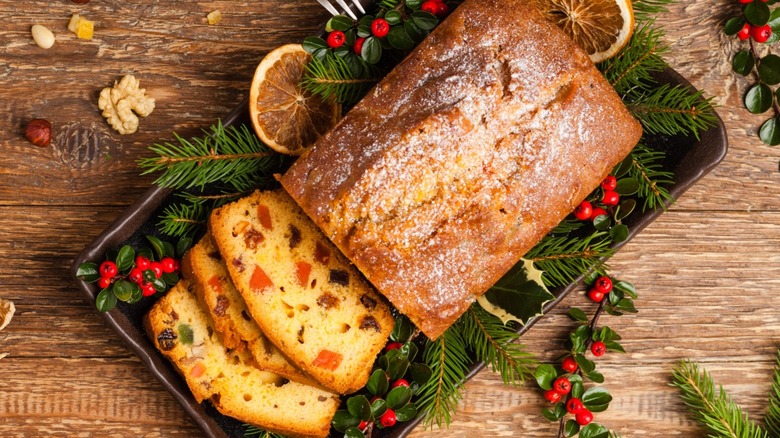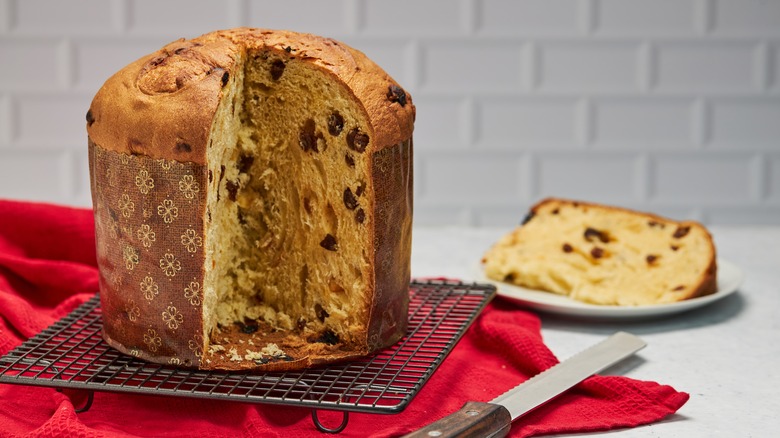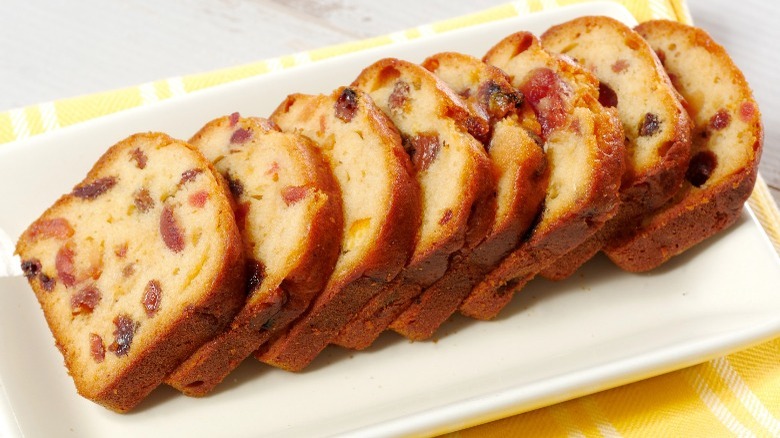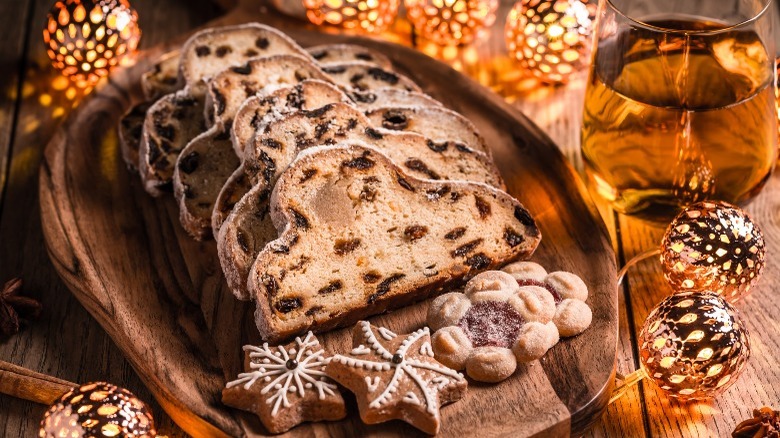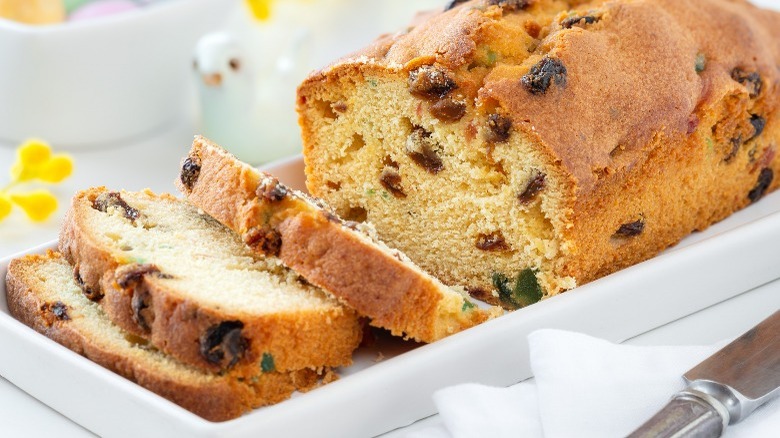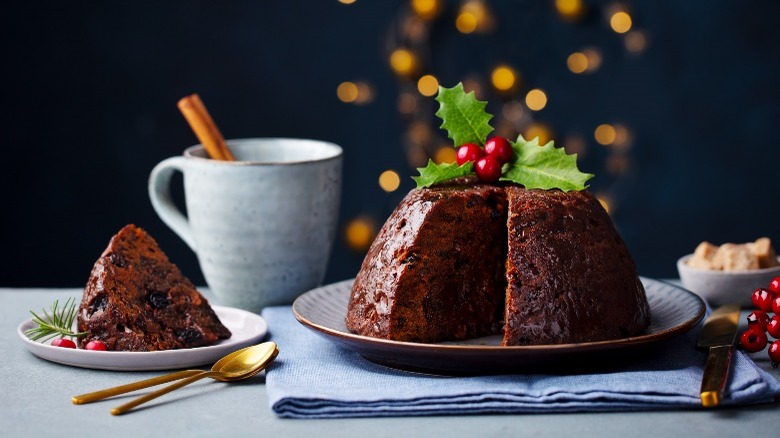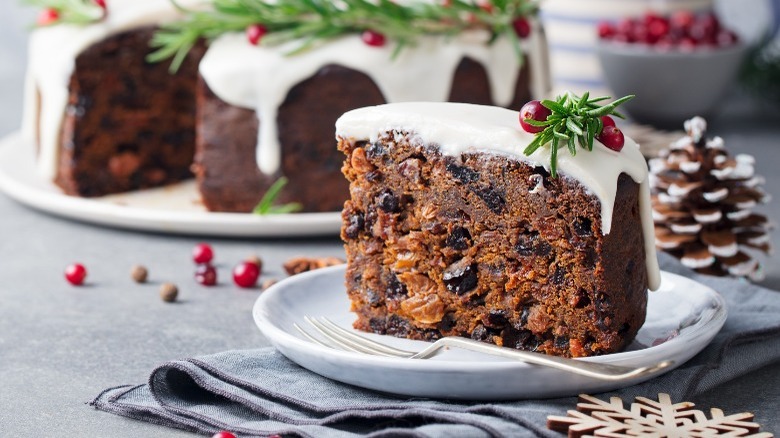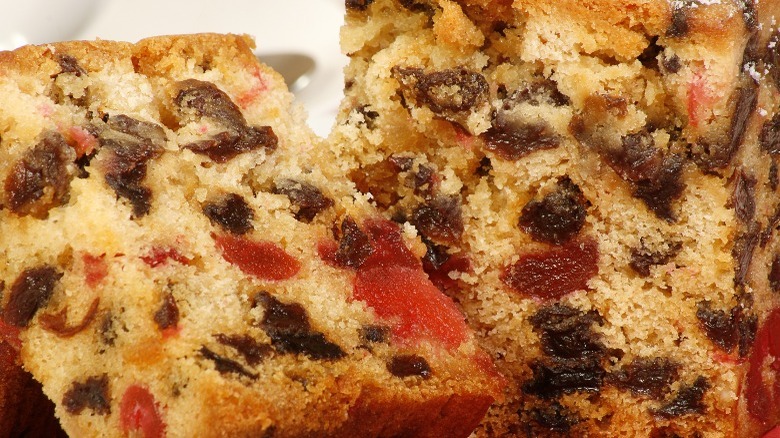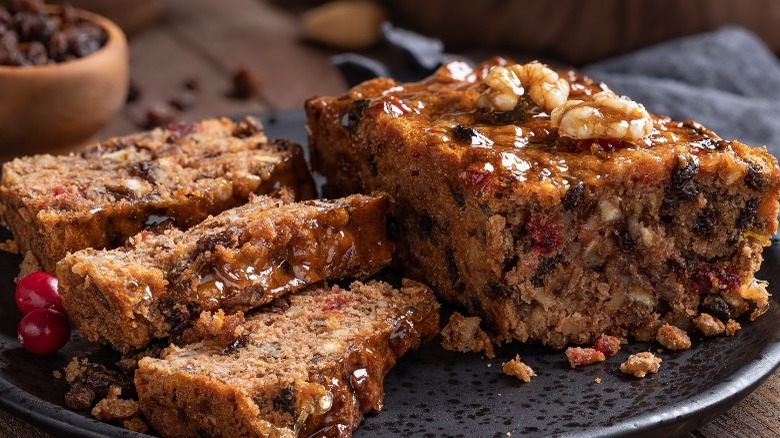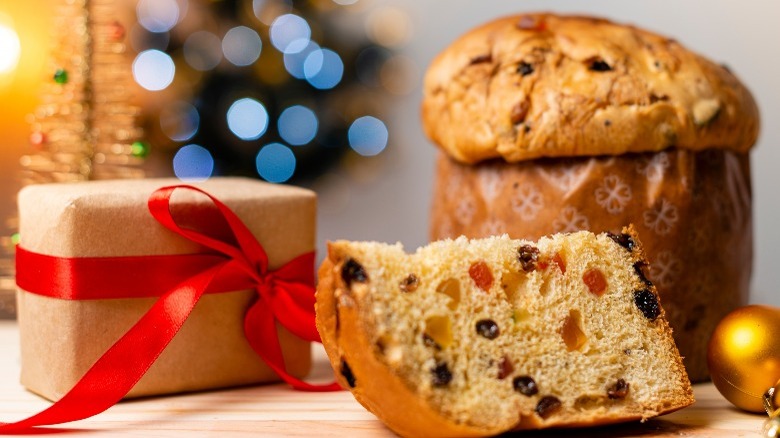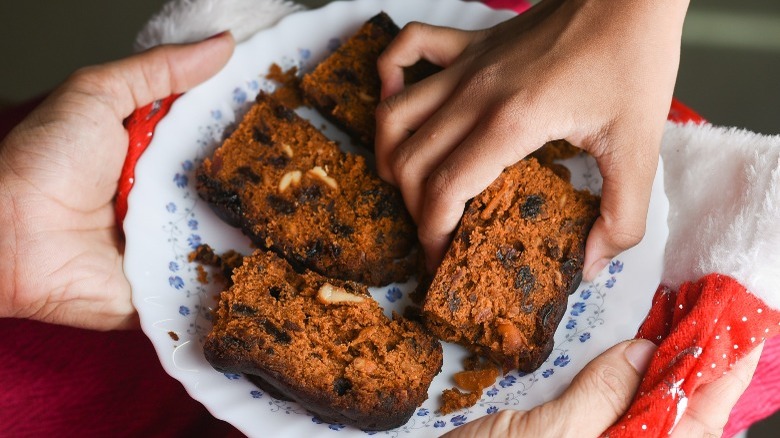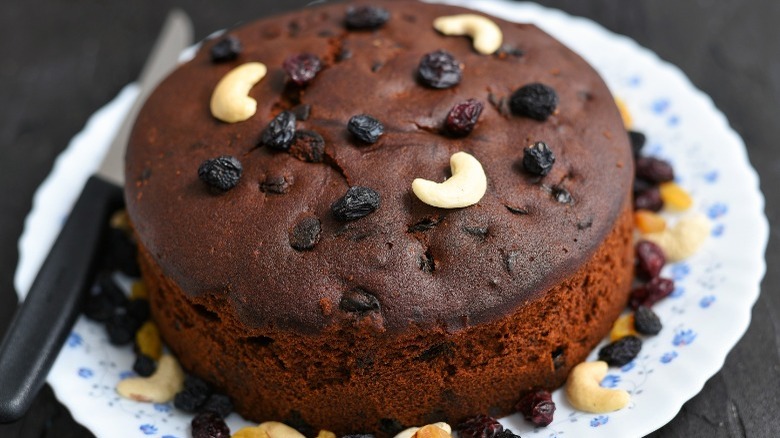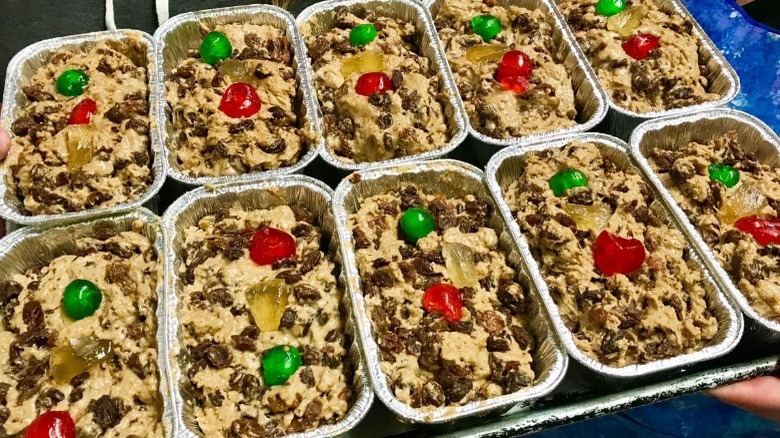The Untold Truth About Fruitcake
Whether you love it, hate it, or love to hate it, fruitcake is a longtime staple of the holiday season. Few other foods inspire such divisive opinions. Throughout its history, fruitcake has been the punchline of jokes, the gift that keeps on giving, and the flavor associated with Christmas for generations. Fruitcake in its modern form may have originated as a delicacy for the wealthy, but its status as a familiar yuletide trope was cemented by its mass production in the early 20th century (via Insider). Now, fruitcake is as much a part of Christmas as Rudolph, Frosty, and the man with the belly and the beard.
If fruitcake is so familiar and omnipresent in our holiday celebrations, why is it so controversial? Does anyone actually eat these weighty loaves, or are they just another ornament to be dragged out to make the table more festive? The lore of the eternally regifted fruitcake calls into question the notion that anyone actually eats the stuff. And yet, the fruitcake tradition endures.
So what's the truth behind this much-maligned confection? Dig into the history and the mystery and learn a little about what makes fruitcake a sweet treat with a sour reputation.
What exactly is fruitcake?
Fruitcake is one of those amorphous things that's hard to describe, but you know it when you see it. And you definitely know it when you taste it. The definition from Merriam-Webster is "a rich cake containing nuts, dried or candied fruits, and spices." As explained in greater detail by The Spruce Eats, fruitcake is a dense combination of fruits and nuts suspended in cake batter that acts like glue to hold it all in place. Light fruitcakes use golden-colored ingredients like pineapple, light corn syrup, and almonds, while darker fruit cakes use molasses and darker fruits like raisins and cherries. Fruitcakes may also contain brandy or rum, which not only preserves them and makes them more palatable but can also help you forget you've eaten one should you find yourself in such a situation.
Differences exist between U.S. and European versions of fruitcake, too (via Collin Street Bakery). In true American fashion, U.S. fruitcake tends to be a glitzy affair, blinged to the max with colorful candied fruit and nuts. In contrast, most European fruitcakes are more modest and more bread-like than the familiar brick-in-a-box fruitcakes found on American holiday tables and in trash cans around the country.
Ancient Romans made an early version to feed soldiers
As old as the fruitcake in your cupboard might be, it's nothing compared to the age of fruitcake in general. Ancient Romans are said to have served a form of fruitcake to soldiers for sustenance while in battle. An article in Smithsonian Magazine describes it as a blend of grain (in this case, barley), with nuts, seeds, and pomegranate. It might have had more in common with modern granola bars than fruitcake. Not the most delicious thing ever eaten, maybe, but neither is the fruitcake we've come to know and eye suspiciously. Maybe long-lost tales tell of Roman soldiers loathing fruitcake like their modern descendants do.
Fruitcake lasted after the Roman Empire fell and weaseled its way through history. After some colorful developments, fruitcake found its way back into infantry kitchens, prepared for soldiers during World War I. The recipe for this new and largely improved version included walnuts or peanuts, dates, and raisins. The list is reminiscent of the ingredients on most Lärabar wrappers. With as many forms as fruitcake has taken through the millennia, it's surprising that the widely-loathed form with neon-colored candied fruit is the one contemporary humans have stuck with. There's always hope for the next generation.
Fruitcake is an indelible Christmas tradition
Once fruitcake became associated with Christmas, there was no shaking it, and not just because of the sugary stickiness of the cake itself. According to Christmas Central, fruitcakes were first associated with ceremonies celebrating specific harvests. Fruitcakes baked in the 16th century as part of England's Twelfth Night festivities included a bean or a coin baked into the mix, as if there weren't enough nuggets in the pan already (via Martha Stewart). Whoever found the lucky token became the king or queen of the party, much like King Cake at Easter. Later, in the 1700s and 1800s, fruitcake was considered a special treat saved for the holidays due to the high expense of the ingredients involved. Truman Capote's story "A Christmas Memory" includes a reference to winter being "fruitcake weather," a literary line that helped reestablish the connection between fruitcake and the holidays for many revelers in the mid-20th century.
The centuries-long association with Christmas has made fruitcakes as festive as wreaths, reindeer, and ringing bells in the city square. Fruitcake and Christmas were tailor-made for one another, a super-sweet coupling that neither time nor the endless ridicule fruitcake continues to receive can come between.
Fruitcake can last a very long time
It only sounded like a joke when "The Tonight Show" host Johnny Carson was credited with saying, "There is only one fruitcake in the entire world, and people keep sending it to each other" (via PBS). The truth is that fruitcake has a tendency to stick around long after the halls have been undecked. One particular fruitcake has been exchanged by friends for nearly seven decades. Per the Clinton Herald, pals Phyllis Eggler and Jeanne Schuyler turned the timeless treat into the gift that keeps on giving ... and giving. And giving. Their tradition began in the late 1950s and was still going strong as of 2020. Each year, the sender disguises the cake, wrapping it in over-large boxes or rerouting it via post to fool the recipient. Talk about committing to the bit.
A fruitcake that lasts more than 60 years may sound pretty impressive until you realize that one particular fruitcake has been maintained for more than 140 years. Julie Ruttinger is the proud keeper of the eternal cake, which was baked by her great-great-grandmother Fidelia Ford in 1878. Safe to say this one is in no danger of being eaten. Not that any of the others are, either.
Victorians popularized fruitcake as a teatime treat
The stodginess of fruitcake seems like a perfect match for Victorian England. Expanded colonialism resulted in the wider availability of sugar, which helped fruitcake recipes gain popularity in English kitchens. Victorian fruitcake was as big a part of the holiday season as the lamp-lined streets hung with wreathes and snow-strewn top hats from Charles Dickens's "A Christmas Carol." But Christmas wasn't the only time Victorian folks enjoyed fruitcake. In addition to being a holiday specialty, the fruitcake recipe of the era was also a popular teatime treat for those who could afford to make it.
If this sounds like a form of punishment rather than a delicious snack, consider what the fruitcake from that time period tasted like. A traditional fruitcake recipe from the Victorian era contains the DNA of modern fruitcake, if not the proportions. Four pounds of flour plus three pounds each of butter and sugar is a lot. But with currants, raisins, spices, and molasses adding flavor, it almost seems reasonable ... appetizing, even, as well as a fine tea accompaniment. Could it be that the crass commercialization of a popular Christmas treat somehow distorted what made people love it to begin with? It wouldn't be the first time.
Fruitcake is seriously heavy for a cake
It only sounds like a joke when people talk about how heavy fruitcake is. The average fruitcake weighs in at a toe-crushing two pounds, and according to MyRecipes, can even weigh as much as a newborn child — a strange yet highly descriptive comparison to make. True, a cake this size contains six to seven servings. But a birthday cake that weighs three pounds and serves around the same number seems much lighter in comparison, even when fully frosted.
So what's the difference? In a word, density. How Stuff Works explains that the density of a well-made fruitcake comes from generous additions of fruits and nuts. In reality, a decent fruitcake should be heavy, but also moist, which is where many recipes go wrong. For anyone undertaking the grueling project that is baking homemade fruitcake from scratch, a cake that's gone dry inadvertently can be revived by wrapping a cake fresh from the oven in a clean dish towel to hold in steam as it cools (via Baking Kneads). It can also help to brush milk or water on the cake to repair the damage done during baking. For the more adventurous, pouring dessert wine over fruitcake before serving can't hurt.
Over two million fruitcakes are sold each year
For such an apparently unpopular food, fruitcake sure holds its own in the holiday treat market. Serious Eats reports that more than two million fruitcakes are sold each year. That's a lot of dense cake moving through the grocery stores and online outlets. Whether they get eaten, thrown away, or end up in Holiday Swap gag gifts is anyone's guess.
As pricing indicates, fruitcake sales are a lucrative part of the Christmas season for retailers. There are cakes sold at different price points for every level of consumer. Amazon's best-seller list for fruitcakes — and yes, there is a best-seller list for fruitcakes, because Amazon has best-seller lists for nearly everything — shows prices ranging from under $13.00 for a one-pound version to a whopping $59.97 for a 48-ounce ring-shaped fruitcake packaged in a collectible holiday tin. Dropping almost 60 bucks on a Christmas cake that not many people like may not be the best way to spend a holiday shopping budget. But for anyone who chooses to take the chance and order up a four-pound slab of questionable holiday cheer, know that there are at least 1,999,999 other shoppers making the same decision.
Fruitcake was outlawed in Europe in the early 18th century
Fruitcake haters may consider the act of giving fruitcake as a Christmas present a criminal offense. The truth is that at one point in its illustrious and checkered history, fruitcake actually was outlawed ... but not for the reason you might think (via Redbook).
In the 1700s, the recipe for fruitcake had grown to include expensive nuts and fruits soaked in sugar and alcohol, similar to the modern version. But these additional elements served to make fruitcake so rich that the authorities deemed it sinful, and the treat was deemed illegal throughout Continental Europe, and not for a little while, either. By the 1800s, laws were relaxed, allowing fruitcakes their rich and rightful place at celebratory feasts once again (via What's Cooking America).
In recent years, a satirical interview on CBC Radio in Canada reintroduced the idea of outlawing fruitcake. A member of the fictitious Canadian Ministry of Seasonal Desserts explained that due to its "extreme lack of popularity," fruitcake was once again illegal. Considering its controversial position in the holiday treat pantheon and its "sinful" history, if any overly sweet Christmas baked good were to be outlawed in modern times, fruitcake is the most obvious and deserving candidate.
Postal delivery expansions helped modern fruitcake spread
If you're searching for someone to thank for the fruitcake industry taking off in the early 20th century, look to your trusty postal service. Before the advent of mail-order food via rural delivery and parcel post, fruitcake could largely be trusted to stay in its own lane as a hand-delivered gift. Once the idea of sending a cherry-covered brick across the U.S. took hold, there was no stopping mail-order fruitcakes from plaguing the country from shore to shore (via Popular Science).
So how much fruitcake moves around the world now that mail delivery is a common occurrence? Claxton and Collin Street, two of the best-known fruitcake creators that reaped the benefits of the shipping boom, produce over four million pounds of fruitcake a year combined. Just knowing the delivery services we rely on these days to bring soup and wireless earbuds and thermal socks helped spread the sugary scourge of fruitcake is enough to wonder whether global consumerism is a mistake. However, the fact that fruitcake had already made hearts merry all around the world before USPS intervened suggests that even without the post office, fruitcake would have found its way into our homes at some point.
Despite its popularity, fruitcake is also widely disliked
As much as fruitcake appears in human history, it would seem this gooey confection was universally loved. Clearly not. Fruitcake is one treat that, as The Travel describes, is just as widely hated, if not more so, than it is appreciated.
What accounts for the mixed reactions that make fruitcake lovers say "Oooo!" while fruitcake haters say "Eewww!" about the same combination of flavors? Pop culture has cast fruitcake as the dense butt of endless jokes, perpetuating its image as a universally panned creation (via TV Tropes). Delish points out that eating a slice of fruitcake delivers a ton of calories without providing an equal amount of enjoyment. With that sort of representation, the adage "There's no such thing as bad press" obviously doesn't apply to fruitcake.
As for the people who do like fruitcake, everyone knows at least one or two people who offer nostalgic recollections of fruitcakes from days gone by to justify their sweet affection. Does the difference lie in the recipe used, the region of the world where the cake is made, or some magical element present in only certain human tastebuds? The mystery persists.
Fruitcakes can be found in cultures around the world
Though associated with America and England, fruitcake can be found around the world. Many cultures enjoy some form of fruitcake as part of their culinary heritage. A Hawaiian version uses Polynesian flavors like macadamia nut and pineapple, India celebrates Christmas with rum-flavored Allahabadi cake, and Vietnam commemorates its Lunar New Year with a fruitcake-styled version of moon cakes called bahn bo mut. There was even a fruitcake discovered in Antarctica, presumably left behind by explorer Captain Robert Scott's Northern Party in 1911 (via USA Today). Unsurprisingly, it had held up for 100 years and was suspected to be edible, which tracks with the durability of most fruitcakes on the market.
Of course, Christmas fruitcakes around the globe include many European creations. Cakes like stollen from Germany, panettone from Italy, and keks from Poland represent a diverse array of cakes that depend on fruits and nuts for flavor and texture. And julekage brings Scandinavian countries a fruitcake that adds cardamom and icing to the mix. With so many variations to try, it's possible that people with an abiding distaste for fruitcake just haven't tasted enough varieties to find one that sticks. Each Christmas brings new hope.
The Great Fruitcake Toss is an annual event in Colorado
Every year in the homey mountain town of Manitou Springs, Colorado, residents and visitors gather for what has become a full-fledged holiday tradition: The Great Fruitcake Toss. This fun-spirited event began in the mid-'90s as a way for bored locals to make use of the town's unwanted fruitcakes. Word of the event spread beyond the town borders and it gradually became a post-Christmas festival where unloved treats can find their true purpose.
The contest has grown from a simple cake toss to a multi-event competition with four divisions. Competitors pay $1.00 per toss, vying for best in distance; accuracy — in which tossers aim their cakes at rings of decreasing size; basket toss; and balance, where competitors carry their cakes on a spatula while running a foot race. There's also a Great Fruitcake Bake-Off that lets participants take their best shot at creating a fruitcake worth loving.
So what's the result of all this sticky competition? In a heartwarming twist, the Great Fruitcake Bake-Off partners with a local food pantry, exchanging tickets for non-perishable food donations. Tossed cakes are fed to Jezebel, the resident pig at nearby SunMountain. A merry treat indeed!
